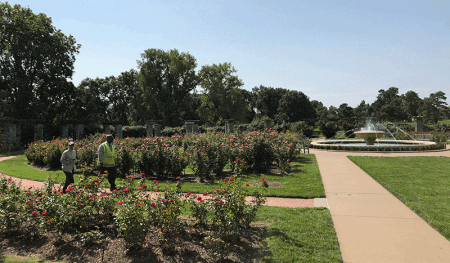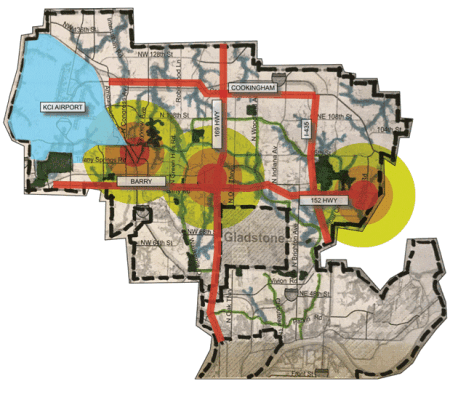The 125-year-old parks system in Kansas City, Missouri, is considered a community jewel. Following the vision of world-renowned city planner George Kessler in the late 1800s, the city has developed parks, greenways, and boulevards along streams to mitigate flooding concerns and connect neighborhoods.
But the parks system also sparked segregation. In the early 1900s, developers and homeowners associations used parks—in addition to discriminatory subdivision restrictions and other practices—to buffer black communities.
A century later, these effects still reverberate in the parks system as development trends, zoning policies, and financial challenges have perpetuated inequity, according to panelists speaking at the ULI Advisory Services presentation. The panel spent the first week of December in Kansas City assessing the parks department and recommending solutions to create a more equitable system.
“During our visits with residents, one resident said that you couldn’t talk about parks without talking about race,” said Karen Abrams, program officer for equitable development with the Heinz Endowments in Pittsburgh. “That’s true for a lot of cities, but there’s a unique character that is presented in Kansas City around its parks.”Decades of land annexations, particularly north of the Missouri River, have fueled many of the inequities, panelists said. The city’s footprint has grown to some 318.6 square miles (825 sq km) from 59.8 square miles (155 sq km) in 1920, while the city’s population has increased to roughly 480,000 from 324,400. Over that time, the parks system has tripled in size to include 12,242 acres (4,954 ha) across 221 parks, 158 miles (254 km) of trails and bikeways, five public golf courses, 135 miles (217 km) of roads and boulevards, museums, community centers, and other amenities.
As a result, parkland in the city’s dense urban core, which has the greatest income, employment, and wealth disparities, is about half that in new and more affluent low-density subdivisions such as Shoal Creek in the north, said David Abraham, a lecturer and research scientist with Rice University in Houston.
“An objective person might say, ‘The inner-city neighborhood has more density and less parkland, so obviously it appears to be a better market to invest in,’” he said. “But we know that’s not the case. We want to highlight the great burden the parks department has in managing the Shoal Creek neighborhood in comparison to the inner-city neighborhood.”
Structural and financial challenges are exacerbating problems that come with unchecked park expansion, said Carlton Brown, panel chair and principal of Direct Invest Development, a New York–based developer focused on communities that have been victims of disinvestment. The parks department has failed to clearly delineate its mission internally or to the public, he said, and needs to engage communities in planning and programming.
Although per capita investment of $126.70 in Kansas City parks is above the national average of $87, the department has failed to leverage that investment to create long-term value for residents or attract new development, Brown added. He partly blamed zoning laws that typically call for one-story buildings around parks.
“You have the potential to offer young people a better urban experience than in any other city in the state of Missouri, or in the region,” he said. “But you don’t have three-story, five-story, or 10-story buildings where you can increase density and offer people that experience.”
@PaulAngelone and the Kansas City, MO ULI Advisory Panel discussing the intersectionality of parks, streetcars and t-shirts. #uli #KCMO #streetcar pic.twitter.com/N6qsJavgMp— Karen Abrams (@KVAbrams) December 4, 2019
A $60 million maintenance backlog and scant reserves to address it are among the system’s other notable flaws, especially as new park development in northern subdivisions increases the system’s sprawl. What is more, the parks department faces a “fiscal cliff,” in part because it competes with other city services for the proceeds of a half-cent sales tax, the parks system’s primary funding source, said Emeka Moneme, managing director for the Menkiti Group, a Washington, D.C.–based real estate development and services firm. Meanwhile, public improvement dollars, which can pay for park projects, are distributed among city council districts equally instead of targeting the highest needs first.
“The resource constraints that we’ve seen really put the equity issues into sharp relief,” Moneme said. “They clearly show where the fault lines are as they relate to our physical asset and programming concerns.”
This morning the @UrbanLandInst Advisory Services team presented the findings of their week-long study on #Equitable Public Spaces and the #KansasCity Parks System. #community #placemaking #diversity #inclusion #parkplanning @KCMOParks pic.twitter.com/wrz6pv35JT— ULI Kansas City (@ULIKansasCity) December 6, 2019
To create a more equitable system, panelists urged the parks department to explore ways to maximize its current resources and to generate more funding. City officials are already beginning to move toward priority-based budgeting, Moneme acknowledged. But the panel recommended that the city conduct a deeper analysis into long-term maintenance costs before adding park assets.
In addition, the panel suggested transferring the oversight of museums, programming, and other services to departments or organizations with core competencies in those areas. That could include giving the public works department the responsibility to maintain the city’s boulevards and parkways.
The panel further proposed repositioning or adding value to certain park assets and selling others. Incorporating mixed-use elements into tennis courts adjacent to the venerable Country Club Plaza district to generate revenues came up in a few discussions, said Kate Humphrey, director of development for public/private partnerships in Detroit’s housing and revitalization department.
Other ideas include restructuring the golf course operation, which serves a small user base. Specifically, the panel called for replacing the flood-prone Heart of America Golf Course with a green stormwater project and leasing part of it to a golf-oriented entertainment company like Top Golf. Moreover, the panel recommended closing and redeveloping one of the two golf courses in the north.
The panel also recommended that the parks department launch conservancy and “friends of the parks” initiatives. Among other activities, the conservancy would raise funds for the overall parks system but focus on in inner-city park reinvestment, too, said Allison Schapker, director of capital projects for the Fairmount Park Conservancy in Philadelphia. It would also support the friends-of-park program, which would be formed by local residents and take part in capital improvement and other decisions.
“Kansas City Parks has a lot of responsibility and a small pie of resources,” Schapker said. “We want to figure out ways to make that pie bigger.”
Thanks to all the panelists for participating in last week’s #10minwalk @UrbanLandInst advisory services panel focused on #KCMO’s park system. Presentation shows how big picture issues impact people then how recommendations can be applied to address them! https://t.co/XcRZtTTitB pic.twitter.com/nRBeEv4c5e— Paul Angelone (@PaulAngelone) December 10, 2019
Parks are essential to the physical, environmental, and economic health of people and communities. 10 Minute Walk is a movement dedicated to improving access to safe, high-quality parks and green spaces in cities—large and small—throughout the United States. Led by the Trust for Public Land, in partnership with the National Recreation and Park Association, and the Urban Land Institute, 10 Minute Walk is working to create a world in which, by 2050, all people live within a 10-minute walk of a park or green space.






